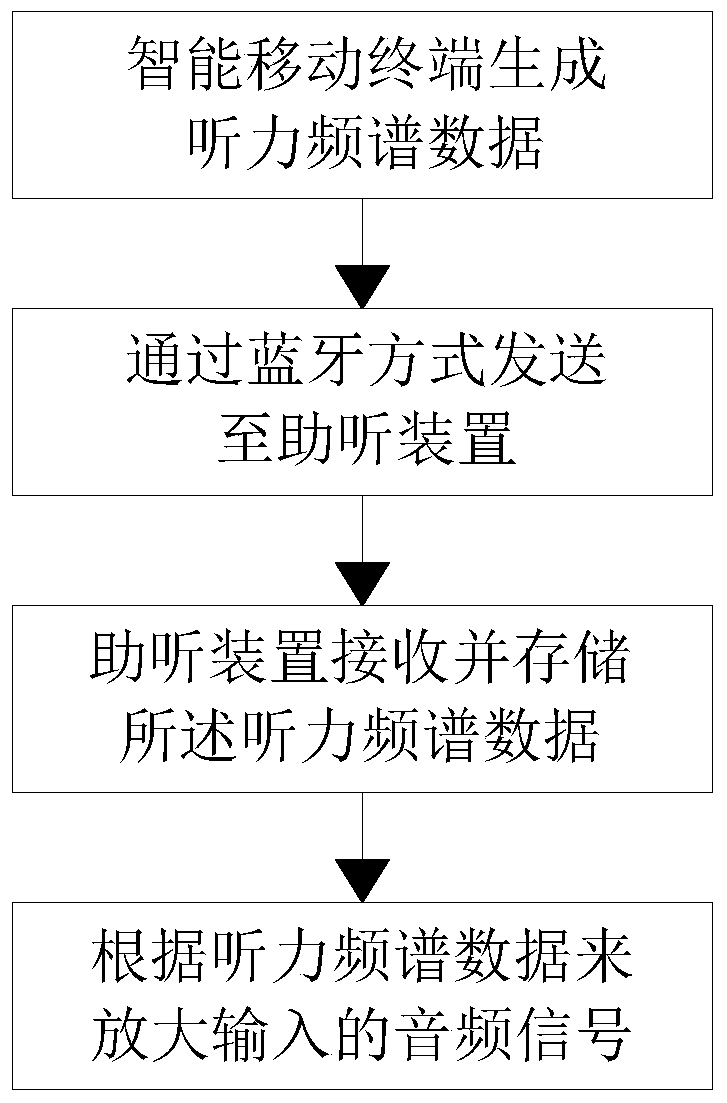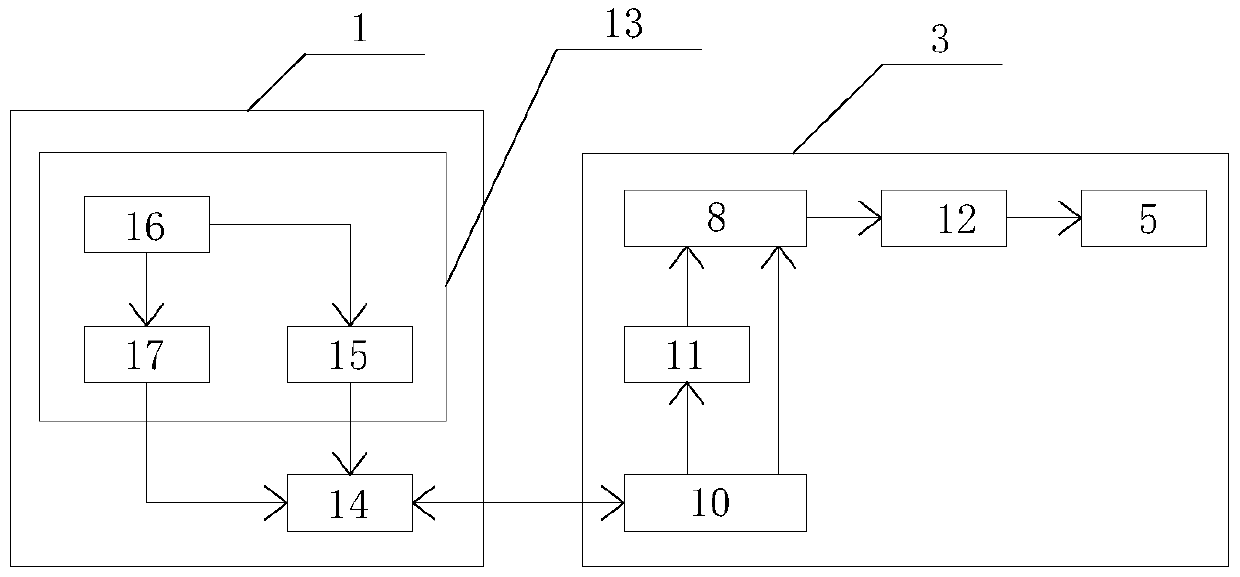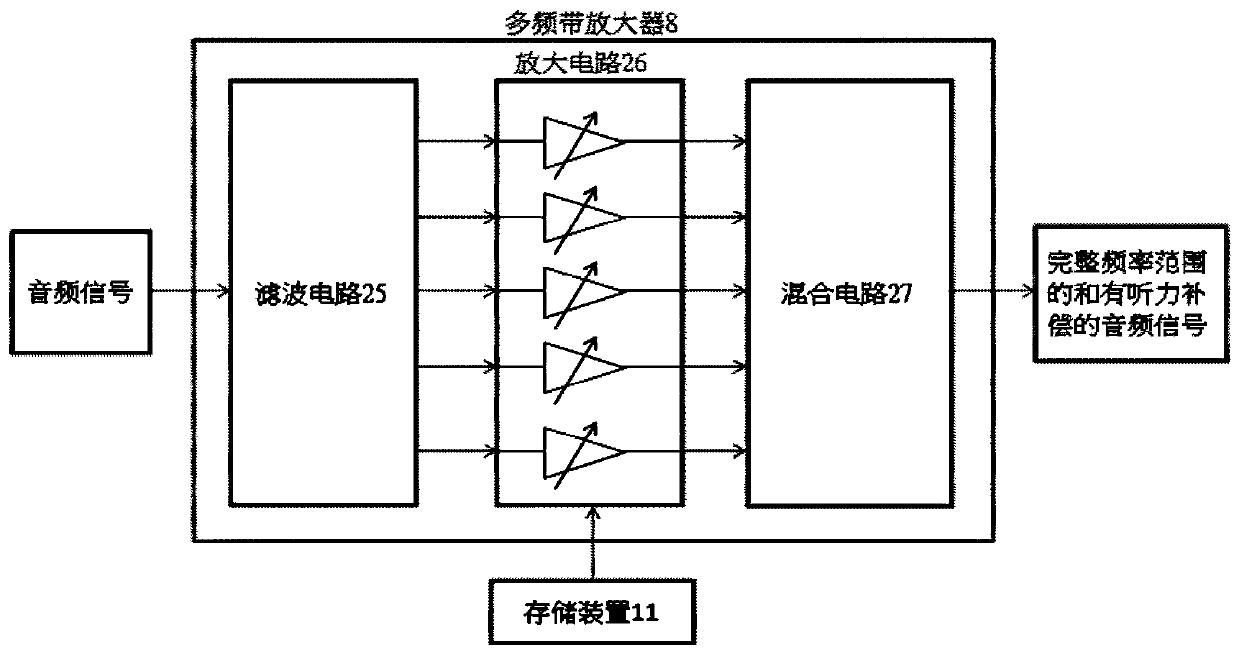Hearing aid method and system with self-tuning function
A function and technology of hearing aid devices, applied in hearing aids, electrical components, etc., can solve problems such as high price, inability to adjust and set different magnifications, and users unable to adjust hearing spectrum data by themselves.
- Summary
- Abstract
- Description
- Claims
- Application Information
AI Technical Summary
Problems solved by technology
Method used
Image
Examples
Embodiment 1
[0069] Embodiment 1: A hearing aid method with self-tuning function, such as figure 1 shown, including the following steps:
[0070] S1, the smart mobile terminal 1 generates hearing spectrum data, and sends it to the hearing aid device 3 through Bluetooth;
[0071] S2. The hearing aid device 3 receives and stores the hearing spectrum data, amplifies the input audio signal according to the hearing spectrum data, and plays the audio signal with bone conduction technology.
[0072] The hearing spectrum data generated in the step S1 is specifically:
[0073] S11, the intelligent mobile terminal 1 divides the audible sound frequency range of the human ear into more than five intervals, and calculates the center frequency (the average value of the minimum frequency and the maximum frequency) of each interval;
[0074] Since the frequency range of sound that can be heard by the human ear is 20Hz to 20000Hz, and the frequency range of human voice is about 65Hz to 1100Hz, the human ...
Embodiment 2
[0091] Embodiment 2: as Figure 4 As shown, the hearing aid device 3 includes an electronic module 4, a left bone conduction speaker 51, a right bone conduction speaker 52, a rechargeable battery 6, a left microphone 71 and a right microphone 72; the electronic module 4 includes a left multi-band amplifier 81, a right Multi-band amplifier 82, power circuit 9, hearing aid device Bluetooth transceiver 10, storage device 11, left bone conduction speaker driver 121 and right bone conduction speaker driver 122; left microphone 71, left multi-band amplifier 81, left bone conduction The speaker driver 121 and the left bone conduction speaker 51 are sequentially connected; the right microphone 72, the right multi-band amplifier 82, the right bone conduction speaker driver 122 and the right bone conduction speaker 52 are connected in sequence; the storage device 11 is respectively connected to the hearing aid The digital signal output interface of the device Bluetooth transceiver 10, t...
Embodiment 3
[0092] Embodiment 3: as Figure 5 As shown, the hearing aid device 3 includes an electronic module 4, a left bone conduction speaker 51, a rechargeable battery 6, a left microphone 71 and a right microphone 72; the electronic module 4 includes a left multi-band amplifier 81, a power supply circuit 9, a hearing aid device Bluetooth Transceiver 10, storage device 11 and left bone conduction speaker driver 121; left multi-band amplifier 81, left bone conduction speaker driver 121 and left bone conduction speaker 51 are connected in sequence; the analog audio frequency of hearing aid device bluetooth transceiver 10 The signal output interface, the left microphone 71, the right microphone 72 and the storage device 11 are all connected to the left multi-band amplifier 81; the storage device 11 is connected to the digital signal output interface of the hearing aid device Bluetooth transceiver 10; the power supply circuit 9 is connected to the rechargeable battery 6 connect.
[0093]...
PUM
 Login to View More
Login to View More Abstract
Description
Claims
Application Information
 Login to View More
Login to View More - R&D Engineer
- R&D Manager
- IP Professional
- Industry Leading Data Capabilities
- Powerful AI technology
- Patent DNA Extraction
Browse by: Latest US Patents, China's latest patents, Technical Efficacy Thesaurus, Application Domain, Technology Topic, Popular Technical Reports.
© 2024 PatSnap. All rights reserved.Legal|Privacy policy|Modern Slavery Act Transparency Statement|Sitemap|About US| Contact US: help@patsnap.com










